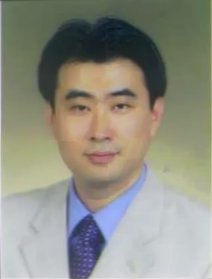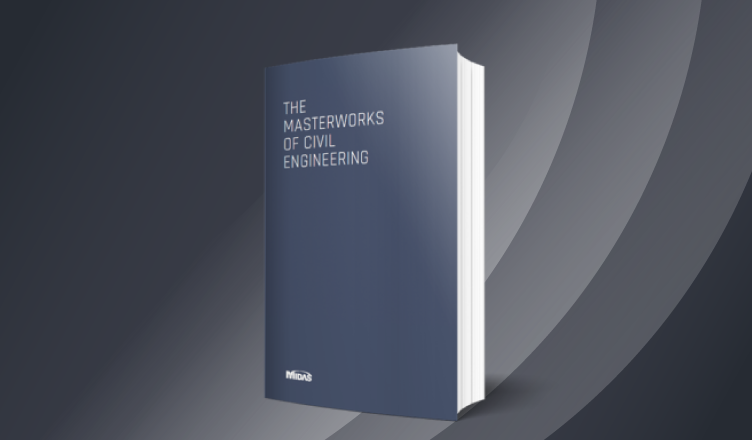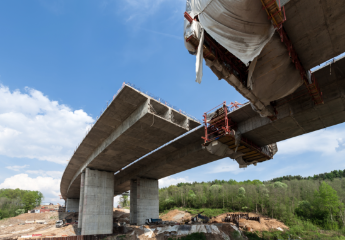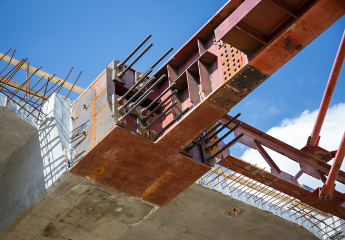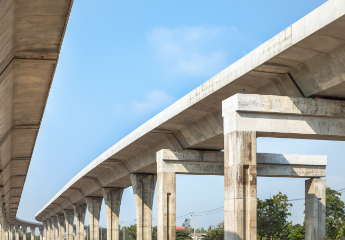Please fill out the Download Section (Click here) below the Comment Section to download the 80 Masterworks of Civil Engineering
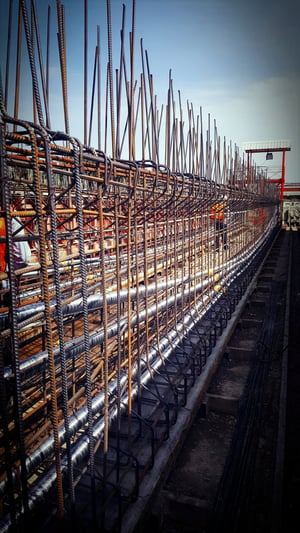
-
-
1. Primary conditions for tendon layout
-
Prestressed concrete is ‘concrete that has been given strength by artificially determining the distribution and size of the stress in advance so that the stress caused by external forces can be offset to a predetermined limit.' Prestress means ‘stress that has been artificially applied to concrete in advance to offset the tensile stresses caused by external forces.
-
If this definition is interpreted backward, it can be interpreted as when tensile stress caused by external forces exceeds certain stress (allowable stress or cracking stress), it can be compensated by applying the prestress accordingly. Here, the tensile stress due to external forces can be thought of as a function of:
①external force, ②geometrical shape (span of structure, boundary condition, etc), and ③ stiffness (materials properties x constant of planned section). If the external forces and the geometries (as planned by the designer) are considered to be given conditions, ‘the tensile stress due to external forces’ can be seen as a function of stiffness, and the prestress to offset the tensile stress also becomes a function of stiffness. In other words, as the cross-section of the structure becomes larger, the prestress needed becomes smaller or unnecessary. If the cross-section of the structure becomes smaller, the prestress needed becomes larger.
As prestress increases, a large number of Tendons (Tendon: components consisting of PT anchorages + tendon + ducts) are required, thereby increasing costs. Therefore, the most important condition that must be considered for tendon arrangement is selecting the most optimal cross-section considering economic feasibility.
2. Theory Applied to Tendons Arrangement
If the schematic cross-section of the structure has been determined through historical documents and case studies, the tendons should be arranged based on their stiffness. The following two theories are contents that designers must be familiar with for efficient tendon arrangement.
Linear transformation of Tendons
The linear transformation of a tendon profile can be defined as the tendon placed on the statically indeterminate structure that rotates around one end without changing its shape within the span; the total bending moment (summation of sectional forces) is the same, but the reaction forces change.
1. If the continuous span is divided into single spans, and the vertical distance from the midpoint of the straight line connecting both ends of the tendons of every single span is the same, the Equivalent distributed force acting on the structure in terms of the load balancing concept becomes the same. However, since the equivalent end force acting on the end of every single span is different depending on the tendon profile arrangement, the moment (primary sectional force) and the deformed shape of every single span differ from each other.
2. If tendons are arranged using linear transformation so that the cross-sectional tendon profile angle (interval angle) of the central point connecting the single-span is 0˚, no additional reaction forces (the cause of secondary sectional forces) occur under boundary conditions, and the moment of every single span becomes the total moment (primary sectional force) of the continuous span.
3. If the linear transformation of the tendon profile arrangement is different from 2) and the cross-sectional tendon profile angle (interval angle) is not 0˚, an additional reaction force (the cause of secondary sectional forces) occurs under boundary conditions to make the tendon profile angle 0˚, where the deformation is equal to 2). Therefore the total moment of the continuous span (Summation of sectional forces) becomes equal to 2).
If the above contents are analyzed using FEM, the results are as shown in the table below.
/River%20Irwell%20Network%20Arch%20Bridge%20Modelling/new%20image%20River%20Irwell%20Network%20Arch%20Bridge%20Modelling/Prestress%20Tendon%20Profile%20Layout%20Considering%20Real%20Construction/image-png-Nov-03-2020-02-16-56-34-AM.png?width=734&name=image-png-Nov-03-2020-02-16-56-34-AM.png)
/River%20Irwell%20Network%20Arch%20Bridge%20Modelling/new%20image%20River%20Irwell%20Network%20Arch%20Bridge%20Modelling/Prestress%20Tendon%20Profile%20Layout%20Considering%20Real%20Construction/image-png-Nov-03-2020-02-17-16-60-AM.png?width=734&height=895&name=image-png-Nov-03-2020-02-17-16-60-AM.png)
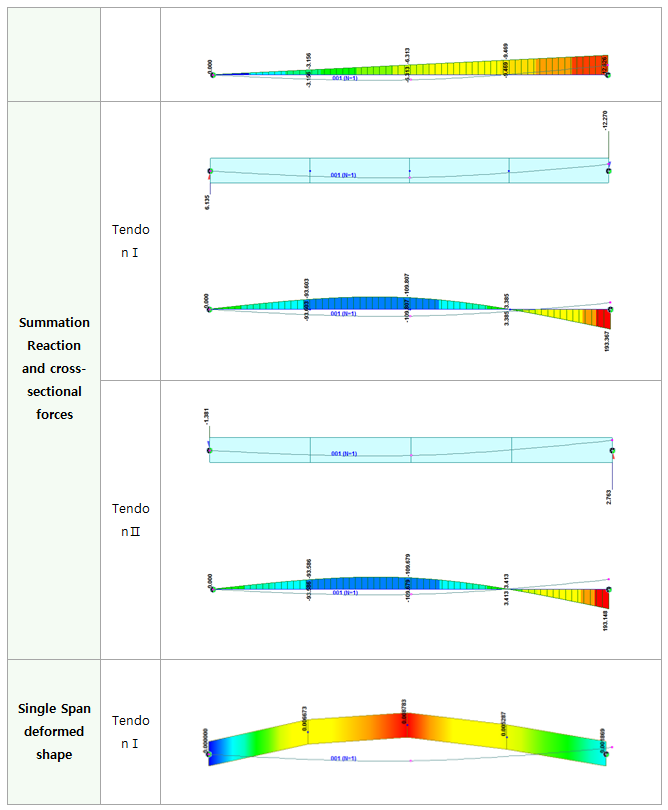
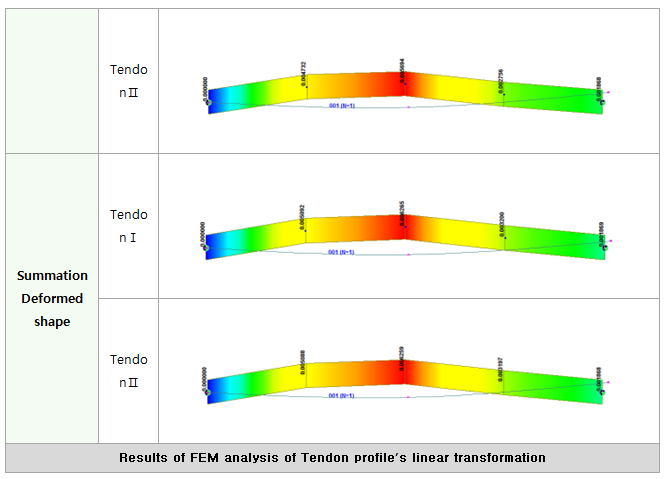
Concordant Arrangement
If the tendon profile is arranged using linear transformation so that the tendon profile angle of the central point is 0˚, as shown in 2) above, no additional reactions will occur under the boundary conditions. This arrangement will be the same as the pressure line (C-line, please refer to relevant PSC books) calculated from the location of the compression force (calculated by considering only the prestress) of the cross-sectional force at each location. In other words, the pressure line is determined by the tendon arrangement profile, and if the tendon profile undergoes linear transformation, the pressure line does not change. When the arrangement of the tendon profile is in the same manner as the pressure line, it is referred to as the concordant arrangement.
This arrangement gives an advantage to the concordant arrangement for statically indeterminate structures since the summation sectional forces are the same and no additional secondary reactions occur (mostly harmful to structures). If the designer intends to arrange the tendon profile similarly to the concordant arrangement, the initially assumed tendon profile arrangement will require a process of determining the pressure line and alignment of the pressure line by linear transformation is necessary, which will inevitably lead to several trials and errors. Therefore, it is necessary to adjust the pressure line so that it does not deviate outside the cross-sectional area by properly assuming the initially assumed tendon arrangement (including the stiffness and tendon volume of the structure) through past experiences or examples.
3. Tendon Arrangement process
The PSC girder design process (Tendon arrangement process) can be classified into four stages: ① model/construction method and section selection, ② satisfactory stress limits, ③ satisfactory deflection limits, ④ satisfactory strength limits.
A. Model/construction method and section selection
As mentioned in Chapter 1, the prestress (which can be seen as the tendon amount) can be seen as a function of ① external forces, ② geometric shape, and ③ stiffness. External forces (mainly specified in the design criteria of each task) and the geometric shape should be considered when selecting the appropriate PSC girder type/construction method and section (which can be seen as ③ stiffness). Detailed comments on this will not be covered because they do not correspond to the purpose of this article, but as an example, please take a look at the table showing previously investigated FCM PSC Box girders. It should not be forgotten that the type/construction of PSC girders and the selection of sections determine the stiffness, which is the primary condition for the designer to perform first for tendon arrangement.
It should not be forgotten that the type/construction of PSC girders and the selection of sections determine the stiffness, which is the primary condition for the designer to perform first for tendon arrangement.
B. Satisfactory stress limits
The design standards (mainly road bridge design standards) for each task stipulate the external forces (loads) to be considered during design and the allowable stress of the tension and concrete member. Accordingly, the tendons shall be arranged to satisfy allowable stresses of tensile and concrete materials. At this time, at least two of the following construction steps must be considered.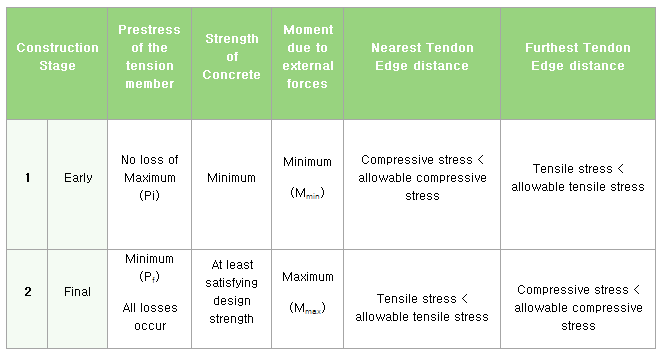 As shown in the table above, the concrete stresses that the initial and final stages of construction must satisfy are opposite to each other.
As shown in the table above, the concrete stresses that the initial and final stages of construction must satisfy are opposite to each other.
The initial/maximum prestress force (Pi) and the final/minimum prestress force (Pf) of the tension member can be calculated using the following equation described in the figure below.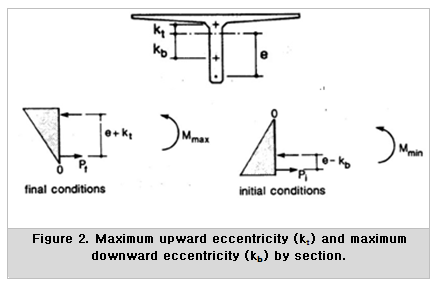
 Here, e: Distance from the center to the tendon’s center.
Here, e: Distance from the center to the tendon’s center.
: Maximum upward eccentricity in sections that only receive compressive stress
: Maximum downward eccentricity in sections that only receive compressive stress
Using the above equation, the tendon arrangement profile can be calculated through the following order.
a. The FEM analysis calculates the initial/minimum moment (Mmin) and final/maximum moment (Mmax), due to external forces, by applying the selected cross-sectional shapes and the completed geometrical shapes.
b. Using the table below, the initial/maximum prestress force (Pi) and the final/maximum prestress force (Pf) of the tension member is calculated. Furthermore, the type of anchorage (number of strands) and the number of tendons are determined.
c. Using the distribution of the initial/minimum moments (Mmin) and the final/maximum moments (Mmax) determined by the tendons and external forces, emax and emin of several positions are determined to calculate the possible tendon arrangement area as shown in Figure 3.
d. Determine the tendon arrangement to be within the tendon arrangement area. Here, the starting and ending points of the PSC girder coincide with the center of the cross-section, and the eccentricity is maximized at the center and intermediate points of the span.
e. Calculate the pressure lines at several critical locations and modify the tendon arrangement using linear transformation to resemble the concordant arrangement.
f. Modify the tendon arrangement so that it has a smooth curve (mainly a circular curve) at the top of the midpoint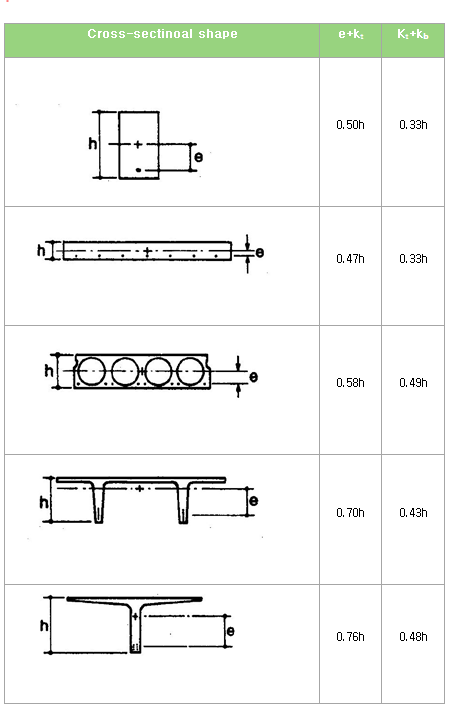
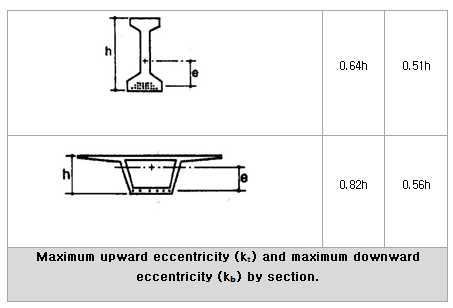
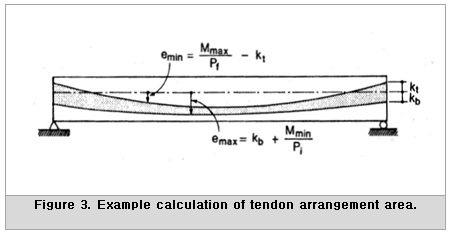
Depending on the girder longitudinal moment distribution, additional tendon arrangements may be required in some sections. In this case, it is desirable to arrange them similar to the previously calculated tendon arrangements.
From personal experience, it is more practical to refer to existing data, such as historical data or designers’ design experiences, because tendon arrangements at each task in the ideal order above can be time-consuming and inefficient. However, it cannot be overlooked that it is a prerequisite that designers must understand the ideal method of tendon arrangement.
Satisfactory deflection limits
PSC girders with tendons arrangement in accordance with the ‘satisfactory stress limits’ should be considered to meet deflection limits to ensure serviceability in accordance with design standards. Deflection limits due to live loads and impact loads are initially considered in the ‘type/construction method and section selection’. On the other hand, the deflection of the dead load+prestress applied is eliminated by the camber (improvement), which is independent of this deflection limit.
Satisfactory strength limits
It shall be examined whether the section in which the tendon is arranged is placed in accordance with the “satisfactory stress limit” ensures safety (design strength > ultimate strength) in ultimate extreme conditions (failure state) according to design standards. In most cases, the strength limit is often satisfied when the tendon is arranged to satisfy the stress limit.
Conclusion
In Chapter 1, we looked at the basic conditions of tendon profile arrangement, and in Chapter 2, we looked at the theory applied to tendon profile arrangement. Lastly, Chapter 3 summarizes the tendon profile arrangement process.
The prestress introduced into the PSC girders is determined by tensile stress due to external forces and the tensile stress is determined by ① external forces, ② geometrical shape (span of structure, boundary conditions, etc), and ③ stiffness (materials properties x constant of planned section). Since the tendon arrangement is based according to its tensile stresses, it can be said that it is determined by the three conditions above. Therefore, the process of determining the arrangement of tendons is important, but we would like to remind you that the type/construction method of the PSC girders and the selection of sections suitable for external forces and geometric shapes are more important
 Get Started midas Civil
Get Started midas Civil
 Featured blog of this week
Featured blog of this week



